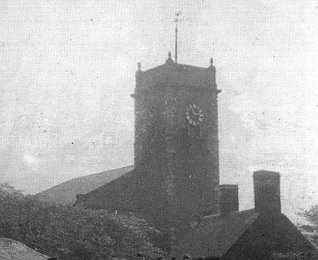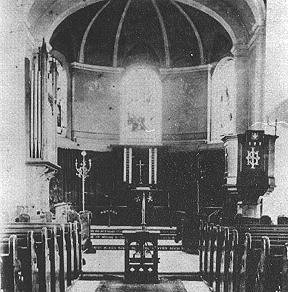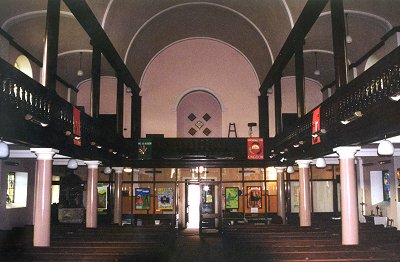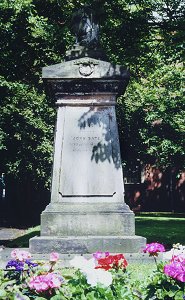|

Listing: 1751. Reconstruction after fire and chancel, 1903, by
F.T.Beck. Classical style.
Literature:
Pevsner, Staffordshire p.300: [Beck] totally replaced the
chancel of 1842-3 by Wyatt & Brandon. The rest must be
facsimile, and apparently a good deal of the exterior may have
been kept. ... The interior is Beck's.
Roger Poole, The Church on Wednesfield Green: the Story of
St. Thomas's Church, Wednesfield, 1750 - 2000, nd[2001],
published by the church.
Comment:
|

The original church, as it was before the
fire. |
Much of Wednesfield's town centre has been
rebuilt in the second half of the 20th century and this church,
the pub next door and a row of cottages near by (all listed) are
almost all that remains of the old place.
Since it was
built St. Thomas's has been pretty much the heart of the place
and continues to stand for Wednesfield and identify it.
|
| The church was built by voluntary subscription
and consecrated in August 1750. Technically, it was
a chapel of ease of St. Peter's, Wolverhampton and
known as the Chapel of St. Thomas in Wednesfield.
In 1849 it became a separate parish with its own
vicar, instead of a curate. In its turn St. Thomas's
established Holy Trinity, Heath Town, as a chapel of
ease, in 1852; Holy Trinity became a parish of its
own in 1869. Likewise, St. Gregory's was
established in 1954 and became a parish of its own
in 1966. Today a team ministry covers this
area.
The interior was extensively altered in the 1840s
when it was widened and a gallery added. There were
further alterations in 1884. In 1902 it was
almost destroyed by fire, said to have been caused
by an overheated stove pipe. |

The interior as it was before the 1884 alterations. |
The fire of the 18th January 1902 fire destroyed most of the
building except the nave and tower. The section of the present tower
below the top windows is original, whereas the upper section including
the clock is new.
 |
The aftermath of the fire. Wolverhampton fire
brigade took about half an hour to reach the church
because several stops were needed en route to rest
the horses. Willenhall fire brigade did not attend
because they could not find any horses.
|
|
The reconstruction after the fire was carried out by F. T. Beck,
a Wolverhampton architect responsible for many buildings in many
styles. The chancel was preserved largely in tact and possibly
some of the side walls.
Certainly such features largely
guided Beck's plans so that it is almost repro - which may be
why it is one of his best looking buildings. |

From an old postcard. |
 |
The interior, looking towards the altar. The
chancel windows survived the fire. They date
from 1872. |
|
The interior, looking towards the west and
the entrance below the tower.
Thanks to the Vicar for permission to photograph the interior. |
 |
From the fire to the rebuilding of the church (which cost
£5,500) was only 19 months.
Beck's interior is very effective, even if some
might feel that the galleries are not quite as well integrated
as they might be. In the traditional way for the style of this
church, the windows on the upper level are plain glass but some
at ground floor level have now had stained glass put in them -
two by Archibald Davies (in 1949 and 1950) and two very good one
by Bronwen Gordon (in 1971)The interior also contains much good
woodwork, the pulpit being very fine.
All the stonework was cleaned in 1983 and the
exterior was lit in 2001.

The Bate Monument.
A fine figured oak board in the north aisle records the
following curates (to 1849) and vicars (thereafter) of St. Thomas's:
|
Richard Nocke
|
1751
|
|
Charles Blackham
|
1793
|
|
William Moreton
|
1804
|
|
John Clare
|
1806
|
|
William Lee Afflett Parker
|
1839
|
|
William Stephens
|
1849
|
|
John Birch
|
1881
|
|
Francis Handley Roach
|
1915
|
|
Guy Heathman Parkhouse
|
1917
|
|
Stanley Arthur Howard
|
1932
|
|
Harry Baylis
|
1942
|
|
Frederick Norman Lewis
|
1956
|
|
Walter John Turner
|
1965
|
|
Barry Rogerson
|
1975
|
|
John Newcombe Craig
|
1979
|
|
John Dudley Dowell Porter
|
1992
|
The board is in error: it seems that there were two curates, Cornelius
Jesson and William Jones who were the first holders of the office; and that
Richard Nocke was not the curate but an assistant.
Barry Rogerson was consecrated the first Bishop of Wolverhampton in 1979.

|